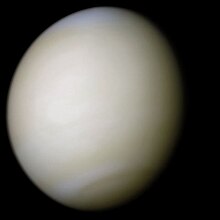Venus

Venus (seembol: ![]() ) is the seicont planet frae the Sun, orbitin it ivery 224.7 Yird days.[1] The planet is named efter the Roman goddess o luve an beauty. Efter the Muin, it is the brichtest naitural object in the nicht sky, reachin an apparent magnitude o −4.6, bricht enough tae cast shadaes.[2] Acause Venus is an inferior planet frae Yird, it niver appears tae ventur far frae the Sun: its elongation reaches a maximum o 47.8°. Venus reaches its maximum brichtness shairtly afore sunrise or shortly efter sunset, for which reason it haes been referred tad bi auncient culturs as the Mornin Star or Evenin Star.
) is the seicont planet frae the Sun, orbitin it ivery 224.7 Yird days.[1] The planet is named efter the Roman goddess o luve an beauty. Efter the Muin, it is the brichtest naitural object in the nicht sky, reachin an apparent magnitude o −4.6, bricht enough tae cast shadaes.[2] Acause Venus is an inferior planet frae Yird, it niver appears tae ventur far frae the Sun: its elongation reaches a maximum o 47.8°. Venus reaches its maximum brichtness shairtly afore sunrise or shortly efter sunset, for which reason it haes been referred tad bi auncient culturs as the Mornin Star or Evenin Star.
Venus is a terrestrial planet an is whiles cried Yird's "sister planet" acause o thair seemilar size, gravity, an bouk composeetion (Venus is baith the closest planet tae Yird an the planet closest in size tae Yird). Houiver, it haes an aa been shawn tae be very different frae Yird in ither respects. It haes the densest atmosphere o the fower terrestrial planets, consistin o mair nor 96% carbon dioxide. The atmospheric pressure at the planet's surface is 92 times that o Yird's. Wi a mean surface temperatur o 735 K (462 °C; 863 °F), Venus is bi far the hettest planet in the Solar Seestem. It haes na carbon cycle tae lock carbon back intae rocks an surface features, nor daes it seem tae hae ony organic life tae absorb it in biomass. Venus is shrouded bi an opaque layer o heichly reflective cloods o sulfuric acid, preventin its surface frae bein seen frae space in veesible licht. Venus micht hae possessed oceans in the past,[3] but thir wad hae vaporized as the temperatur rose due tae a runaway greenhoose effect.[4] The watter haes maist probably photodissociated, an, acause o the lack o a planetary magnetic field, the free hydrogen haes been swept intae interplanetary space bi the solar wind.[5] Venus's surface is a dry desertscape interspersed wi slab-lik rocks an periodically refreshed bi volcanism.
References[eedit | eedit soorce]
- ↑ "Venus: Facts & Figures". NASA. Archived frae the original on 29 September 2006. Retrieved 12 Apryle 2007.
- ↑ Lawrence, Pete (2005). "The Shadow of Venus". Archived frae the original on 11 Juin 2012. Retrieved 13 Juin 2012.
- ↑ Hashimoto, G. L.; Roos-Serote, M.; Sugita, S.; Gilmore, M. S.; Kamp, L. W.; Carlson, R. W.; Baines, K. H. (2008). "Felsic highland crust on Venus suggested by Galileo Near-Infrared Mapping Spectrometer data". Journal of Geophysical Research, Planets. 113: E00B24. Bibcode:2008JGRE..11300B24H. doi:10.1029/2008JE003134.CS1 maint: multiple names: authors leet (link)
- ↑ B.M. Jakosky, "Atmospheres of the Terrestrial Planets", in Beatty, Petersen and Chaikin (eds,), The New Solar System, 4th edition 1999, Sky Publishing Company (Boston) and Cambridge University Press (Cambridge), pp. 175–200
- ↑ "Caught in the wind from the Sun". ESA (Venus Express). 28 November 2007. Retrieved 12 Julie 2008.
Freemit airtins[eedit | eedit soorce]
- Venus Profile Archived 2011-08-31 at the Wayback Machine at NASA's Solar Seestem Exploration steid
- Missions tae Venus (Hostit bi NASA)
- Gallery o Venus exploration images (Hosted bi NASA)
- The Soviet Exploration o Venus, Image catalog
- Venus page at The Nine Planets
- NASA page aboot the Venera missions
- Magellan mission home page
- Pioneer Venus information frae NASA
- Detailed information aboot transits o Venus
- Geody Venus, a sairch ingine for surface featurs
- Cairts o Venus in NASA Warld Wind
- Chasin Venus, Observin the Transits o Venus Smithsonian Institution Libraries
- Venus Crater Database Lunar an Planetary Institute
- Calculate/show the current phase o Venus Archived 2007-09-22 at the Wayback Machine (U.S. Naval Observatory)
- Venus Astronomy Cast episode No. 50, includes full transcript.
- Thorsten Dambeck: The Blazing Hell Behind the Veil Archived 2010-01-18 at the Wayback Machine, MaxPlanckResearch, 4/2009, p. 26–33
Cartographic resoorces[eedit | eedit soorce]
- PDS Cairt-a-Planet & Venus Nomenclature Archived 2011-07-21 at the Wayback Machine
- Gazeteer o Planetary Nomenclature – Venus (USGS)
- Cairt o Venus
- Movie o Venus Archived 2011-07-21 at the Wayback Machine at Naitional Oceanic an Atmospheric Admeenistration


